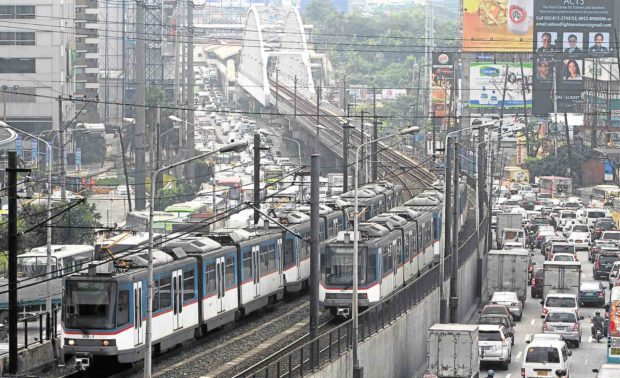MRT 3 broke down more than 500 times last year

LINE OF SIGH Spotty maintenance and other problems plaguing Metro Rail Transit 3 continue to derail moves to improve mass transport on Edsa. —EDWIN BACASMAS
The country’s busiest and problem-plagued rail line ended 2017 with yet another service interruption on New Year’s Eve, bringing the number of times its operations had been disrupted and passengers had been unloaded to more than 500 for the entire year.
The Metro Rail Transit 3 (MRT 3) management said nearly 2,000 passengers “voluntarily disembarked from the trains and discontinued their journey” at 6:54 a.m. on Sunday after a signaling problem was detected.
Sunday’s service interruption came a day after MRT 3 unloaded 200 passengers an hour before they were supposed to get free rides in commemoration of the Dec. 30 martyrdom of national hero Jose Rizal.
An MRT 3 statement said a train motor early on Saturday failed due possibly to “worn-out electrical sub-components.”
According to information posted on the company’s website, Saturday’s incident was the 448th time in 2017 that the MRT 3 unloaded passengers. That’s about six times in five days that passengers had been forced to disembark for the whole of 2017.
Article continues after this advertisementThe figure is 15 percent more than the 379 times that passengers were unloaded in 2016, according to records of the rail line, which transports an average of 463,000 people daily.
Article continues after this advertisementThe aborted trip early on Sunday was caused by a “signaling problem,” according to the MRT 3 management.
The signaling system controls the train’s movements through railway signals to prevent collisions.
The MRT 3 management said its control center was aware of the problem but could not “fully locate or determine the failure.”
In response, its stations temporarily stopped taking in new passengers and refunded 1,959 already aboard who wanted to discontinue their journeys.
The signaling system was restored at 7:54 a.m. and the train resumed normal services five minutes later.
Aside from frequent disruptions, MRT 3’s operations in 2017 were marred by a “decoupling” in late November. No one was hurt after the last coach of the train separated from the two others on the northbound line between the Ayala and Buendia stations.
Other misfortunes struck the MRT 3 in the latter part of the year. In November, a female passenger accidentally fell on the tracks from the platform and one of her arm was cut off when the train’s wheels rolled over it. Another female passenger collapsed and died inside the train in December.
The Department of Transportation (DOTr) has cited the lack of available spare parts as one reason for the train’s frequent breakdowns. It was also one of the reasons the contract with the maintenance provider, Busan Universal Rail Inc. (Buri), was terminated in November.
The government has since taken over the train’s maintenance.
Prior to his resignation, former Transport Undersecretary for Rails Cesar Chavez committed to provide a more efficient service within “three to six months.”
Taking responsibility for the glitches and breakdowns that continued to plague the MRT 3, Chavez resigned in late November.
The DOTr said that it had procured P8.66 million worth of spare parts for its rolling stock and another P7.33 million worth of parts for the tracks.
Assistant Secretary for Rails TJ Batan said in a statement that some of the spare parts have been delivered and the others were expected to arrive in 30 to 90 days.
“We got the commitment of all suppliers to exert best efforts to deliver earlier than the prescribed contractual lead times, and our MRT 3 team will focus on realizing this,” he said.
The rolling stock spare parts contract has a budget of P8.89 million and was won by Linkers Enterprises. The spare parts contract, with a budget of P7.97 million, was won by Nikka Trading, Batan said.
The contract for the independent audit and assessment (IAA), with a budget of P48 million, was awarded to TUV Rheinland for P45.31 million.
The DOTr said the IAA will cover all sub-components of MRT 3, including its signaling system, tracks and rolling stock. The current fleet of 73 Czech-made trains and the 48 Chinese-made trains, which are still unused, would also be audited and assessed.
The DOTr is also finalizing an official development assistance agreement with Japan for MRT 3’s rehabilitation and maintenance.
Batan said the Philippines and Japan were expected to exchange notes verbale by the first week of January. The DOTr and railway engineers from the Japan International Cooperation Agency would then conduct a due diligence study of the MRT 3 until April “to clearly identify the needed rehabilitation works,” he said.